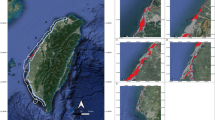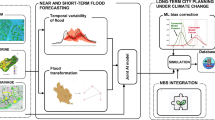Abstract
Due to long-term human activity interference, the Hainan Tropical Rainforest National Park (HTRNP) of China has experienced ecological problems such as habitat fragmentation and biodiversity loss, and with the expanding scope and intensity of human activity impact, the regional ecological security is facing serious challenges. A scientific assessment of the interrelationship between human activity intensity and habitat quality in the HTRNP is a prerequisite for achieving effective management of ecological disturbances caused by human activities and can also provide scientific strategies for the sustainable development of the region. Based on the land use change data in 2000, 2010, and 2020, the spatial and temporal variations and the relationship between habitat quality (HQ) and human activity intensity (HAI) in the HTRNP were explored using the integrated valuation of ecosystem services and trade-offs (InVEST) model. System dynamics and land use simulation models were also combined to conduct multi-scenario simulations of their relationships. The results showed that during 2000–2020, the habitat quality of the HTRNP improved, the intensity of human activities decreased each year, and there was a negative correlation between the two. Second, the system dynamic model could be well coupled with the land use simulation model by combining socio-economic and natural factors. The simulation scenarios of the coupling model showed that the harmonious development (HD) scenario is effective in curbing the increasing trend of human activity intensity and decreasing trend of habitat quality, with a weaker trade-off between the two compared with the baseline development (BD) and investment priority oriented (IPO) scenarios. To maintain the authenticity and integrity of the HTRNP, effective measures such as ecological corridor construction, ecological restoration, and the implementation of ecological compensation policies need to be strengthened.
Similar content being viewed by others
References
Anselin L, Rey S J, 2014. Modern Spatial Econometrics in Practice: A Guide to GeoDa, GeoDaSpace and PySAL. Chicago: GeoDa Press.
Bi Manyu, Zhong Yexi, Xiao Zeping et al., 2023. Spatial and temporal change of habitat quality of Poyang Lake Basin in China at small watershed scale and its multidimensional response to landscape pattern. Chinese Geographical Science, 33(3): 565–582. doi: https://doi.org/10.1007/s11769-023-1357-x
Forrester J W, 1968. Principles of Systems. Cambridge, MA: MIT.
Gao Zhoubing, Wang Xiaorui, Sui Xueyan et al., 2022. Multiscenario prediction of habitat quality in Nanjing based on FLUS and InVEST models. Journal of Agricultural Resources and Environment, 39(5): 1001–1013. (in Chinese)
Greenpeace, 2011. Report on natural forest changes in tropical Hainan released by Greenpeace. Environmental Protection. 24: 6–7. (in Chinese)
Gu Mingrui, Wang Fan, Wang Shuhong, 2021. Simulation of China’s green development policy based on system dynamics. Chinese Journal of Environmental Management, 13(3): 126–135. (in Chinese)
Han N L, Yu M, Jia P H, 2022. Multi-scenario landscape ecological risk simulation for sustainable development goals: a case study on the central mountainous area of Hainan Island. International Journal of Environmental Research and Public Health, 19(7): 4030. doi: https://doi.org/10.3390/ijerph19074030
Hassan R, Scholes R, Ash E, 2005. Ecosystems and Human Well-Being,. Washington, DC, USA: Island Press, 60–69.
He S T, Wang D J, Zhao, P et al., 2022. Dynamic simulation of debris flow waste - shoal land use based on an integrated system dynamics-geographic information systems model. Land Degradation & Development, 33(12): 2062–2075. doi: https://doi.org/10.1002/ldr.4298
Horne B V, 1983. Density as a misleading indicator of habitat quality. The Journal of Wildlife Management, 47(4): 893–901. doi: https://doi.org/10.2307/3808148
Humborg C, Ittekkot V, Cociasu A et al., 1997. Effect of Danube River dam on Black Sea biogeochemistry and ecosystem structure. Nature (London), 386(6623): 385–388. doi: https://doi.org/10.1038/386385a0
Leu M, Hanser S E, Knick S T, 2008. Human footprint in the West: a large-scale analysis of anthropogenic impacts. Ecological Applications, 18(5): 1119–1139. doi: https://doi.org/10.1890/07-0480.1
Li Ang, Ye Changqing, Zhu Lirong et al., 2022. Impact from land use/land cover change on function of water yield service: a case study on National Park of Hainan Tropical Rainforest. Water Resources and Hydropower Engineering, 53(5): 36–45. (in Chinese)
Li Feng, Shi Benlin, 2023. A study on the intention of indigenous residents to support the construction of national parks: take Hainan Tropical Rainforest National Park as an example. Journal of Natural Resources, 38(6): 1602–1617. (in Chinese). doi: https://doi.org/10.31497/zrzyxb.20230614
Liang X, Guan Q F, Clarke K C et al., 2021. Understanding the drivers of sustainable land expansion using a patch-generating land use simulation (PLUS) model: a case study in Wuhan, China. Computers, Environment and Urban Systems, 85: 101569. doi: https://doi.org/10.1016/j.compenvurbsys.2020.101569
Liu Chunxia, Li Yuechen, Yang Hua et al., 2011. RS and GIS-based assessment for eco-environmental sensitivity of the three gorges reservoir area of Chongqing. Acta Geographica Sinica, 66(5): 631–642. (in Chinese)
Liu Shiliang, Liu Lumeng, Wu Xue et al., 2018. Quantitative evaluation of human activity intensity on the regional ecological impact studies. Acta Ecologica Sinica, 38(19): 6797–6809. (in Chinese)
Liu X P, Liang X, Li X et al., 2017. A future land use simulation model (FLUS) for simulating multiple land use scenarios by coupling human and natural effects. Landscape and Urban Planning, 168: 94–116. doi: https://doi.org/10.1016/j.landurbplan.2017.09.019
Liu Yuan, Zhou Yong, Du Yuetian, 2019. Study on the spatiotemporal patterns of habitat quality and its terrain gradient effects of the Middle of the Yangtze River economic belt based on InVEST model. Resources and Environment in the Yangtze Basin, 28(10): 2429–2440. (in Chinese)
Miller R B, 1994. Interactions and collaboration in global change across the social and natural sciences. Ambio, 23(1): 19–24. http://www.jstor.org/stable/4314156
Riedler B, Lang S, 2018. A spatially explicit patch model of habitat quality, integrating spatio-structural indicators. Ecological Indicators, 94: 128–141. doi: https://doi.org/10.1016/j.ecolind.2017.04.027
Sanderson E W, Jaiteh M, Levy M A et al., 2012. The human footprint and the last of the wild. BioScience, 52(10): 891–904. doi: https://doi.org/10.1641/0006-3568(2002)052[0891:THFATL]2.0.CO;2
Saunders D A, Hobbs R J, Margules C, 1991. Biological consequences of ecosystem fragmentation: a review. Conservation Biology, 5(1): 18–32. doi: https://doi.org/10.1111/j.1523-1739.1991.tb00384.x
Shen Zhongjian, Zeng Jian, 2021. Spatial relationship of urban development to land surface temperature in three cities of southern Fujian. Acta Geographica Sinica, 76(3): 566–583. (in Chinese)
Silva C, Leiva F, Lastra J, 2019. Predicting the current and future suitable habitat distributions of the anchovy (Engraulis ringens) using the Maxent model in the coastal areas off central-northern Chile. Fisheries Oceanography, 28(2): 171–182. doi: https://doi.org/10.1111/fog.12400
Sun Yongguang, Zhao Dongzhi, Gao Yang et al., 2014. Evaluation method of human activity intensity based on remote sensing—a case study in Beihai, Guangxi coastal zone. Marine Environmental Science, 33(3): 407–111, 424. (in Chinese)
Tropical forestry editorial department, Forestry department of hainan province, 2022. High-level and high quality construction of Tropical Rainforest National Park Hainan strives to create a national park ‘Hainan Sample’. Tropical Forestry, 50(04): 1. doi: https://doi.org/10.3969/j.issn.1672-0938.2022.04.002
Wang Q, Wang H, 2023. Evaluation for the spatiotemporal patterns of ecological vulnerability and habitat quality: implications for supporting habitat conservation and healthy sustainable development. Environmental Geochemistry and Health, 45(5): 2117–2147. doi: https://doi.org/10.1007/S10653-022-01328-3
Wang Qifan, 1995. New progress in theory and methodology of system dynamics. Systems Engineering-Theory Methodology Applications, 4(2): 6–12. (in Chinese)
Wang Yu, Fu Bitian, Lü Yongpeng et al., 2016. Assessment of the social values of ecosystem services based on SolVES model: a case study of Wusong Paotaiwan Wetland Forest Park, Shanghai, China. Chinese Journal of Applied Ecology, 27(6): 1767–1774. (in Chinese)
Wang Ziyao, Huang Chuli, Li Liang et al., 2022. Ecological zoning planning and dynamic evaluation coupled with Invest-HFI-PLUS model: a case study in Bortala Mongolian Autonomous Prefecture. Acta Ecologica Sinica, 42(14): 5789–5798. (in Chinese)
Weber D, Schaepman-Strub G, Ecker K, 2018. Predicting habitat quality of protected dry grasslands using Landsat NDVI phenology. Ecological Indicators, 91: 447–460. doi: https://doi.org/10.1016/j.eco-lind.2018.03.081
Wei Fang, Liu Jing, Xia Liheng et al., 2022. Landscape ecological risk assessment in Weibei dryland region of Shaanxi Province based on LUCC. China Environmental Science, 42(4): 1963–1974. (in Chinese)
Wu M, Ren X Y, Che Y et al., 2015. A coupled SD and CLUE-S model for exploring the impact of land use change on ecosystem service value: a case study in Baoshan District, Shanghai, China. Environmental Management, 56(2): 402–419. doi: https://doi.org/10.1007/s00267-015-0512-2
Xu Jiannan, Chao Bixiao, Peng Lingli et al., 2023. Ecological corridor construction of Hainan Tropical Rainforest National Park. Journal of Southwest Forestry University (Natural Science), 43(6): 125–134. (in Chinese)
Xu Yong, Xu Xiaoren, Tang Qing, 2016. Human activity intensity of land surface: concept, methods and application in China. Journal of Geographical Sciences, 26(9): 1349–1361. doi: https://doi.org/10.1007/s11442-016-1331-y
Yu Fuqin, Zhang Baiping, Wang Jing et al., 2021. Suggestions for the Qinling National Park Construction based on experiences of international large-scale ecological corridors. Journal of Natural Resources, 36(10): 2478–2490. (in Chinese). doi: https://doi.org/10.31497/zrzyxb.20211003
Zhang Xueru, Zhou Jie, Li Mengmei, 2020. Analysis on spatial and temporal changes of regional habitat quality based on the spatial pattern reconstruction of land use. Acta Geographica Sinica, 75(1): 160–178. (in Chinese)
Zhao Y Y, Song J X, Cheng D D et al., 2019. Comprehensive evaluation and scenario simulation for the water resources carrying capacity in Xi’an City, China. Journal of Environmental Management, 230: 221–233. doi: https://doi.org/10.1016/j.jenvman.2018.09.085
Zhou Ting, Chen Wanxu, Li Jiangfeng et al., 2021. Spatial relationship between human activities and habitat quality in Shennongjia Forest Region from 1995 to 2015. Acta Ecologica Sinica, 41(15): 6134–6145. (in Chinese)
Author information
Authors and Affiliations
Contributions
HAN Nianlong: conceptualization, methodology, writing-review and editing, funding acquisition; YU Miao: formal analysis and investigation, data curation, writing-original draft preparation; JIA Peihong: funding acquisition, supervision; ZHANG Yucheng: data curation; HU Ke: data curation.
Corresponding author
Ethics declarations
The authors have no competing interests to declare that are relevant to the content of this article.
Additional information
Foundation item: Under the auspices of the National Social Science Found of China (No. 21XGL019), Hainan Provincial Natural Science Foundation of China (No. 421RC1034), Professor/Doctor Research Foundation of Huizhou University (No. 2022JB080)
Rights and permissions
About this article
Cite this article
Han, N., Yu, M., Jia, P. et al. Influence of Human Activity Intensity on Habitat Quality in Hainan Tropical Rainforest National Park, China. Chin. Geogr. Sci. 34, 519–532 (2024). https://doi.org/10.1007/s11769-024-1423-z
Received:
Accepted:
Published:
Issue Date:
DOI: https://doi.org/10.1007/s11769-024-1423-z




